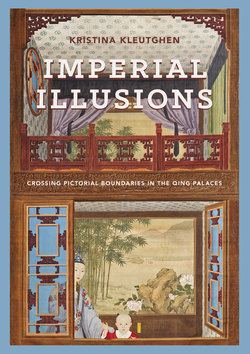Читать книгу Imperial Illusions - Kristina Kleutghen - Страница 96
На сайте Литреса книга снята с продажи.
Оглавление2.13 Detail of the second illustration of the “layer method” for spatial recession. From Nian Xiyao, The Study of Vision. The Bodleian Libraries, University of Oxford, Douce Chin. B. 2, p. 55r.
created a compelling document of a European object not otherwise known to have circulated in eighteenth-century China, but also presented a unique method for producing illusionistic paintings.
Nian’s treatise culminates in the ninth section (57r–75r) with an extended visual lesson on cast shadows created with rays of light from a single light source, represented as diagonal solid lines extending over a figure to the ground. The cast shadows are merely silhouetted with dotted lines tracing the blank shape of the shadow on the ground below the object; not with dark infilled or cross-hatched patches that would otherwise give the shadow substance. This section begins with simple generic rectilinear and curved polyhedrons to establish the method, but the final case study objects are specifically Chinese forms, including a hexagonal basin stand, ceramics such as the teapot (figure 2.8), a man in fur-lined aristocratic Manchu winter dress and hat (figure 2.14), and a stalking tiger next to an arched door (figure 2.15). The man and the animal immediately make a cultural
